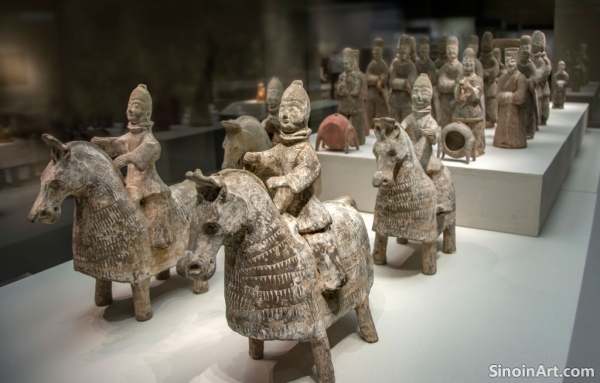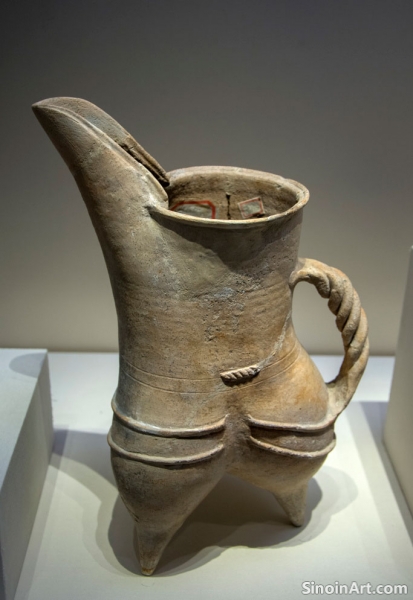Tang Ceramics and the Tea Ceremony
|
While not as central as in later periods, the tea ceremony was beginning to gain popularity during the Tang Dynasty, and this had a subtle but significant impact on ceramic production. The growing appreciation for tea and the rituals surrounding its consumption influenced the development of specific ceramic forms and styles. The Tang tea culture, while not as formalized as in later dynasties, laid the groundwork for the widespread use of ceramics in tea service.  One of the key influences of tea culture on Tang ceramics was the demand for suitable tea bowls. Tang tea bowls were often broad and shallow, with wide mouths and relatively low foot rims. This shape was particularly suitable for whisking tea, a practice that was becoming increasingly popular during the Tang Dynasty. The desire for functional yet aesthetically pleasing tea bowls drove innovation in ceramic form and design.  The color and glaze of Tang tea bowls were also influenced by the ritualistic aspects of tea drinking. While sancai and other brightly colored wares were common during the Tang Dynasty, tea bowls were often made of celadon or other darker-colored glazes. These subdued hues provided a perfect backdrop for appreciating the color and clarity of the brewed tea. This preference for subtle elegance reflects the growing appreciation for the sensory experience of tea.  Beyond tea bowls, other ceramic objects used in the tea ceremony also emerged during the Tang Dynasty. Teapots, ewers for pouring hot water, and small dishes for serving tea cakes were all part of the evolving tea culture. The shapes and designs of these objects reflected the functionality and aesthetics demanded by tea practitioners. These pieces, while often utilitarian, were not without a sense of beauty and grace. The relationship between tea and Tang ceramics reflects the broader cultural shifts taking place during the dynasty. The growing popularity of tea was not just a matter of taste, it was also a reflection of a more sophisticated and refined lifestyle. The ceramics associated with tea, therefore, played a vital role in both the practical and symbolic aspects of Tang society. |
Tag : Tang Dynasty tea bowls, Chinese tea ceremony, ancient tea pottery, celadon tea ware, influence of tea on ceramics
Related information
- The Vibrant World of Tang Ceramics: An Overview
- The Forms of Tang Ceramics: Function and Artistry
- Tang Dynasty Tomb Figures: A Window into the Past
- Sancai Ware: A Symphony of Three Colors
- Tang Ceramics and Foreign Trade
Tang Dynasty ceramics (618-907 AD) are characterized by vibrant colors, diverse forms, and innovative techniques, most notably three-color (sancai) glazes, reflecting the prosperity and cultural exchange of the era.
Tang Dynasty ceramics feature diverse forms ranging from elegant ewers and sancai tomb figures to robust storage jars and architectural elements, showcasing the intersection of function, artistry, and the diverse needs of the era.
Tang Dynasty tomb figures, often decorated with sancai glazes, provide insights into the era's daily life, fashion, and beliefs, depicting court ladies, officials, soldiers, and animals, reflecting detailed craftsmanship and vibrant artistry.
Sancai, meaning “three-color” in Chinese, is perhaps the most iconic ceramic ware of the Tang Dynasty. These vibrant and richly glazed pieces are instantly recognizable for their combination of green, amber, and cream or straw-yellow glazes. While the term suggests a limited palette, the actual range of colors could vary, sometimes incorporating blues and purples, creating a dazzling visual spectacle. Sancai ware wasn’t just about color; it was a bold statement of Tang aesthetics and technical prowess.
The Tang Dynasty's open trade policies and the prominence of the Silk Road facilitated the widespread distribution of Tang ceramics to foreign lands. These ceramic wares, renowned for their beauty and quality, became valuable commodities in international trade, bringing Tang artistry and craftsmanship to distant corners of the world. The impact of this trade was significant, not only economically but also culturally.